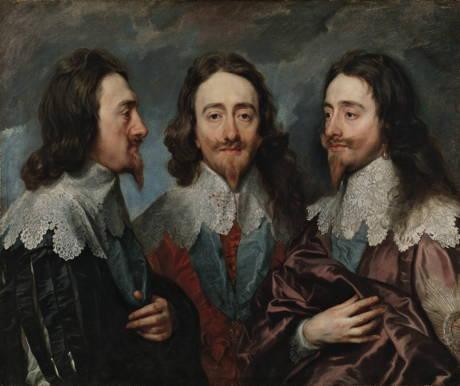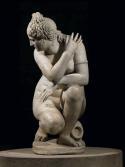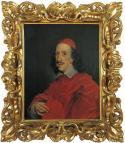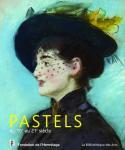Art Of The Day Weekly
#500 - from 1 February 2018 to 7 February 2018

Anthony van Dyck, Charles I in Three Positions, 1635–36. Oil on canvas, 84.4 x 99.4 cm. Royal Collection Trust / © Her Majesty Queen Elizabeth II, 2018.
IN THE AIR
Collecting, the one unpunished vice
Everyone collects something or other in our day. Be it stamps, racing cars, corkscrews, magnets, antique tools, and of course, drawings and paintings. In other times, not everyone had the means to satisfy such a passion. But those who did often handled sums of money that put them at the same level as our current oligarchs. The coincidences of cultural calendars have two of the most famous collectors of the 17th century, whose exquisite taste is proven in the major museums in the world, are being celebrated at the same time: Charles I in London, Leopoldo de’ Medici in Florence. This long distance deal mobilized the greatest stars of their times, which each of the sponsors wished to attract through prestigious offers, something like the today’s football clubs fighting over the geniuses of the round ball. The Messi, Ronaldo and Mbappé of those long gone times were exchanged in a similar mercato, and were called Van Dyck, Rubens or Gentileschi.
EXHIBITIONS

Roman, Aphrodite (‘The Crouching Venus’), second century AD Marble, height 119 cm RCIN 69746 Royal Collection Trust / © Her Majesty Queen Elizabeth II 2018
Charles I, an aesthete king
LONDON – He did not live to be very old, as his reign was shortened as well as his body, when he was decapitated in 1649 at the age of 48. Charles I Stuart was not too keen on politics, and left it in the hands of clever Cromwell. He did take the time though to build one of the most beautiful art collections in history. The Royal Academy of Arts has undertaken to bring together an important part of it. It was not an easy ask, as the collection was scattered to all corners of the world, a few short months after the monarch’s head rolled off the block, on a cold January morning. That was also a disastrous month for Louis XVI of France, by the way. While his son and successor Charles II (1660-1685) endeavored to bring a certain number of art works back home, such as Venus with Mercury and Cupid by Correggio, many paintings and sculptures of the collection are still the pride and joy of world famous museums. Among others we have The Supper at Emmaus by Titian at the Louvre, or the portrait of Henrietta, the King’s French wife, by Van Dyck, at the National Gallery in Washington. Charles did not only buy, he also commissioned Rubens, Guido Reni, and others of the like, as well as local artists. The tapestry workshops of Mortlake for example, delivered a superb interpretation of the Acts of the Apostles by Raffaello.
• Charles I: King and Collector at the Royal Academy of Arts, from 27 January to 15 April 2018.
Leopoldo, prelate and collector
FLORENCE – Just a few years later, the fate of Leopoldo de' Medici (1617-1675) was not as dramatic as that of the Stuart king, even if the status of the Medici family was not always prestigious at certain times in Tuscany. The fate of his collection was also more stable: his nephews gave the greatest part to the Uffizi Gallery. Leopoldo was the son of Cosimo II and an Austrian archduchess, and these mixed origins stimulated varied and cosmopolitan interests. Not only for painting, but also for antiques that were brought to him from Rome and Naples, where the diggings unveiled treasures, like this basalt statue of a young man wearing a toga. There were also the scientific instruments, among which the ones used by Galileo, or some exotic curiosities – Japanese lacquers or marks in travertine marble original from Teotihuacán… In order to quench his thirst for art, Leopoldo rushed his agents throughout the continent. Among his passions, there is one the exhibition highlights, his taste for artists’ self-portraits. He collected many of these, to draw a sort of history of the biographical art of his time.
• Leopoldo de’ Medici, principe dei collezionisti at the Palazzo Pitti, until 25 February 2018.
Pessoa and his bulimia
MADRID – In his own way Fernando Pessoa (1888-1935) was a collector. He accumulated pseudonyms, each one with such a strong identity, such a life of his own, that they can be called heteronyms. There are nearly one hundred! In creating them, the poet also created a series of terms. The latter, aside from their simple lexical inventiveness, can be interpreted as a description of the Portuguese avant-gardes of his time, from intersectionism to sensationism. The exhibition that highlights his creativity is logically accompanied by works of his contemporaries such as Souza Cardoso, a real discovery at the Grand Palais, in Paris, two years ago; Almada-Negreiros or Sarah Affonso, while the excitement of Lisbon in the years between the two World Wars is expressed by a selection of experimental reviews.
• Pessoa, toda arte es una forma de literatura at the Reina Sofía, from 7 February to 7 May 2018
BOOKS
32 shades of pastel
Recently, the Petit Palais in Paris, based on its sole collection, gave a glimpse into the wealth of pastels and its various expressions. The Fondation de l’Hermitage in Lausanne will take over from 2 February to 21 May, based on private collections, and bolstered by museums that are wealthy in this type of work. Consequently, the Kunstmuseum Winterthur, the Jenisch museum, the museums of Geneva among others will be contributing to the exhibition. This malleable matter allows the artist to create surprising monochrome symphonies of grey and black (Armand Guillaumin), as well as multicolored explosions (Augusto Giacometti). The more specialized are brought together in this catalogue, from Rosalba Carriera to Sam Szafran, including of course the major player in this field, Degas. While avoiding discoveries such as that by Firmin Baes, with his Jeune Fille au chou (Young girl with a cabbage), the book does not ignore contemporary art which continues, on the margin, to use this old medium, as we can see in the works of Sean Scully or Nicolas Party.
• Pastels du 16e au 21e siècle, directed by Sylvie Wuhrmann and Aurélie Couvreur, La Bibliothèque des Arts/Fondation de l’Hermitage, 2018, 224 p., €49.
OPENINGS OF THE WEEK

JEAN-CHARLES DE CASTELBAJAC
3 February 2018 - PARIS - Galerie Magda Danysz
A couturier who likes to build bridges between, art, fashion and popular culture


